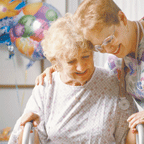Retirement Living: Skilled Nursing

Over several months, we’ve examined different aspects of retirement living and the issues many people face when deciding what might be best for a loved one. A Continuing Care Retirement Community (CCRC) offers several levels of retirement living, all in one place. All aspects of this type of community are designed to enhance the lifestyle of the person living there. This is one reason there are many different levels of services.
The level we’ll explore this month is one many of us would rather not have to think about: skilled nursing, as it’s generally referred to these days, is a far cry from the nursing homes of the past. The trend in facilities today is “patient-centered” care, with staff being trained that they’re working in the patient’s home, and they should act accordingly. Often, patients aren’t required to adhere to the facility schedule, but rather can select the time they prefer to rise in the morning and order meals from a menu—rather than just being served whatever is in the cafeteria that day.
Therapy and rehabilitation is the focus whenever possible, and many CCRCs have their own on-site therapy facility. Of course, there are many different reasons a person could require nursing care: illness, surgery, stroke, Alzheimer’s, etc. It’s imperative that, when searching for a place for your loved one, you learn about the facility and its values. What’s the mission statement? Do they have specialized units for different types of care? Are activities designed specifically for the needs and abilities of the patient?
It’s also important to know whether the facility staffs only the minimum number of nursing staff or if they have more than required. There are many new developments in the treatment of memory-related disorders, and there are facilities with units dedicated specifically to Alzheimer’s and dementia that gear the entire environment to the individual suffering from a memory-related disorder.
This is the trend in long-term care. Skilled nursing today truly can offer a better quality of life by bringing life to patients when they can no longer go out to it. Another benefit of having a loved one who lives in a CCRC is that often they’re given preferential spots in the skilled nursing facility linked to their CCRC; therefore, the family doesn’t have to worry about finding a place for them. You may find it can be difficult to get into some skilled nursing facilities because of their excellent reputations. This is another reason it’s good to plan ahead. It can be a scary time, but most good facilities will have people who can help you through it.
Once again, the most important thing to remember is to ask a lot of questions because the lowest price often isn’t the best bargain. Talk to the staff, and see if you’re comfortable with the director and activities staff. If possible, speak with the director of nursing or care coordinator; these will be people who help to determine the course of treatment for your loved one. TPW
